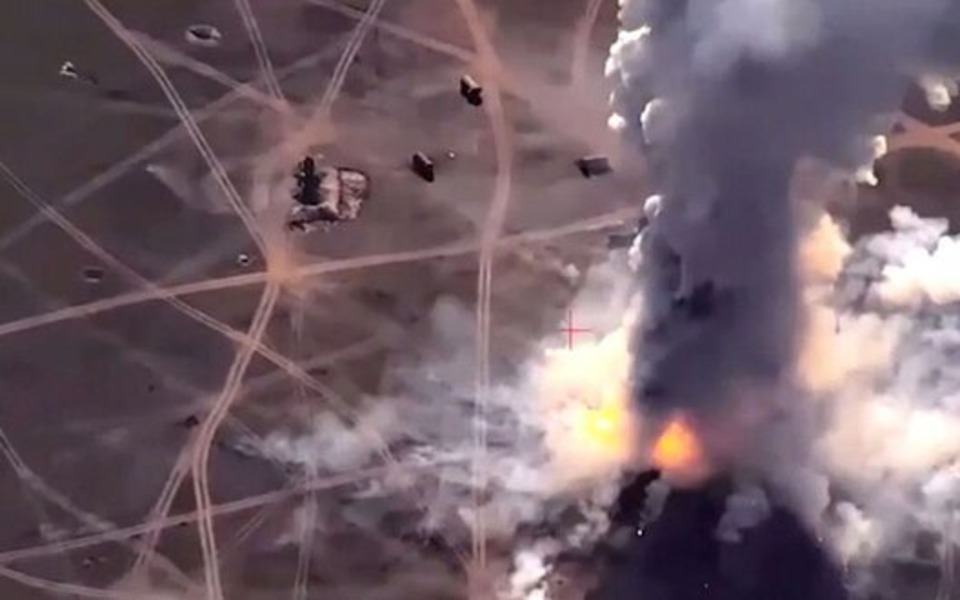Who could have imagined that this year Ukraine’s Independence Day would be celebrated with a spectacular performance by the Ukrainian Armed Forces in Crimea, featuring a billion-dollar fireworks display and the raising of the flag?
On August 23, in the vicinity of Cape Tarkhankut in Crimea, the latest Russian air defense system, the S-400 «Triumph,» with a price tag of 1.2 billion dollars, was destroyed by a new Ukrainian missile. The personnel and three more S-300 missile launchers were also eliminated. All of this took place during the day, likely for high-quality video recording by a Ukrainian drone flying nearby, which this air defense system was meant to counter. This is the very air defense system that was marketed as a more advanced counterpart to the American «Patriot.»
Simultaneously, a unit of Ukraine’s Military Intelligence (GRU), in collaboration with the Ukrainian Navy, engaged in combat aboard patrol boats and routed a Russian Su-30SM fighter jet in the vicinity of Snake Island.
Following these actions, despite being detected, they continued their mission. On the next day, August 24, they conducted a landing operation deep in the area of the same Tarkhankut, where they destroyed dozens of occupiers, several enemy vehicles, and completed a series of undisclosed tasks. In the end, they raised the Ukrainian flag on one of the buildings and returned without losing a single soldier.
This operation is not merely unprecedented in its conception and audacity in reducing the reconnaissance and military capabilities of the occupiers in a strategically vital area. Besides the «Triumph» air defense system, this area also hosts the Russian army’s radar node with the Nebo-M radar and the Kasta-2E2 radar, positions equipped with supersonic «Onyx» coastal anti-ship missiles and the «Pantsir-S1» anti-aircraft missile system, as well as a training ground for Russian infantry. There are even fortifications designed to protect against attacks from the sea, popularly referred to as «castles in the sand.»
These actions are not merely propaganda events designed to humiliate the military dignity of the occupiers who once, in violation of maritime law, took ramming actions and sank underpowered Ukrainian ships in 2018 while crying, «Crush him! Crush!»
Despite international law, which stipulates that Russia only owns 10% of the Black Sea coast, de facto, starting from the occupation of part of Georgia in 2008, Moscow has expanded its influence to one-third of the region.
This is a powerful platform for influencing the Mediterranean, the Middle East, North Africa, and Southern Europe. Moscow has attempted to strengthen this influence earlier this year through its withdrawal from the grain deal, shelling Ukrainian ports, and issuing pirate ultimatums to civilian vessels.
However, by employing asymmetric actions, a «strategy of small cuts» involving naval drones, precision missiles, and well-coordinated special operations, Kyiv is destroying bridges, warehouses, oil depots, air defenses, ships, tankers, airfields, and occupiers. This nullifies Moscow’s efforts, depriving it of its main advantage. In just the past month, Russia lost three ships, two of which, the «Bykov» and «Olenegorsky Miner,» were engaged in combat missions.
All of this keeps the Russian fleet on edge, forcing it to rely more on Novorossiysk for logistics, adding two days to transit times, and severely limiting its operational participation in the military campaign. This also places Russian civilian vessels, using Black Sea ports for exporting stolen Ukrainian grain, evading sanctions, and profiting from the sale of oil resources, in an economically unfavorable position.
These are systematic military actions of the highest order, part of a larger operation that punched a hole in Crimea’s air defense shield, which is better protected than Moscow’s. They have also influenced the current Ukrainian counteroffensive. Most importantly, they have created a trend towards a strategic shift in the balance of power in the Black Sea basin, which Russia traditionally considers its sphere of influence, in favor of Ukraine.
Despite international law, under which Russia only has sovereignty over 10% of the Black Sea coastline, de facto, starting from the occupation of part of Georgia in 2008, Moscow has expanded its influence to one-third of the region.
This serves as a powerful platform for influencing the Mediterranean, the Middle East, North Africa, and Southern Europe. Russia attempted to strengthen this influence earlier this year by withdrawing from the grain deal, shelling Ukrainian ports, and issuing pirate ultimatums to civilian vessels.
However, Kyiv, through asymmetric actions, a «strategy of small cuts» involving naval drones, precision missiles, and well-coordinated special operations, is destroying bridges, warehouses, oil depots, air defenses, ships, tankers, airfields, and occupiers. This negates Moscow’s efforts, depriving it of its main advantage. In just the past month, Russia lost three ships, two of which, the «Bykov» and «Olenegorsky Miner,» were engaged in combat missions.
All of this keeps the Russian fleet on edge, forcing it to rely more on Novorossiysk for logistics, adding two days to transit times, and severely limiting its operational participation in the military campaign. This also places Russian civilian vessels, using Black Sea ports for exporting stolen Ukrainian grain, evading sanctions, and profiting from the sale of oil resources, in an economically disadvantageous position.
The recent actions of the Ukrainian Defense Forces on the peninsula not only prematurely closed the velvet season but also demonstrate to the world, including those raised in the fear of the once formidable USSR, that Crimea, once considered an «unsinkable» aircraft carrier that Russia spent nine years building in the name of «Russian glory,» is inevitably turning into a place of military shame.

